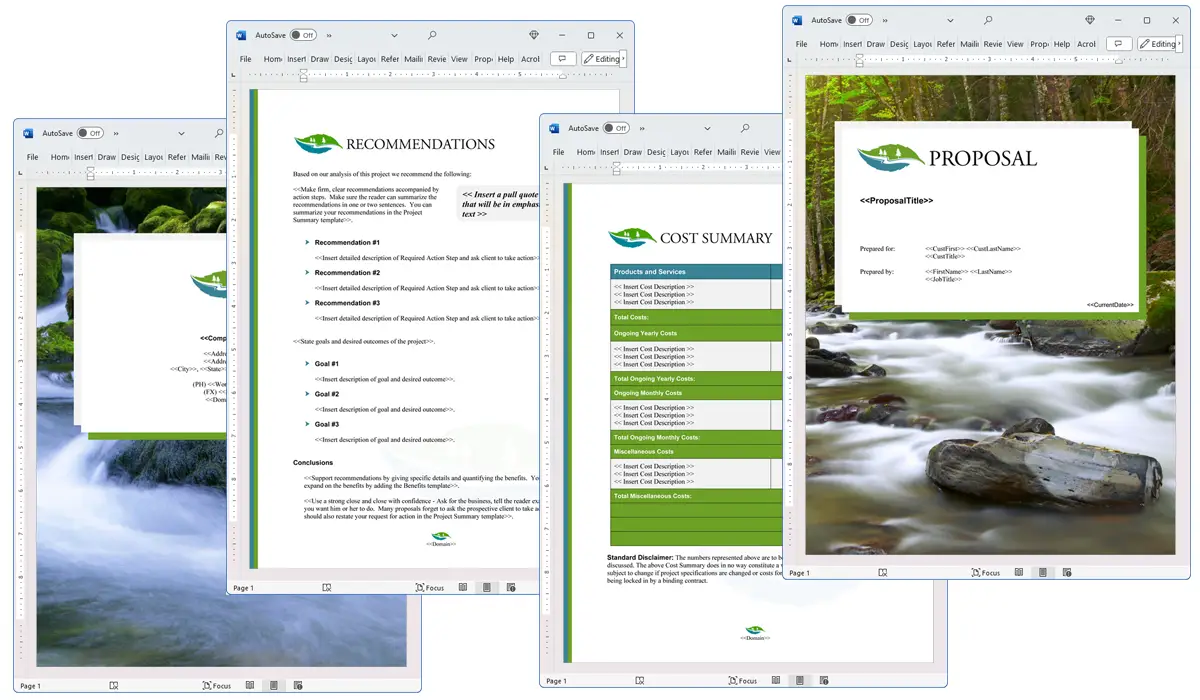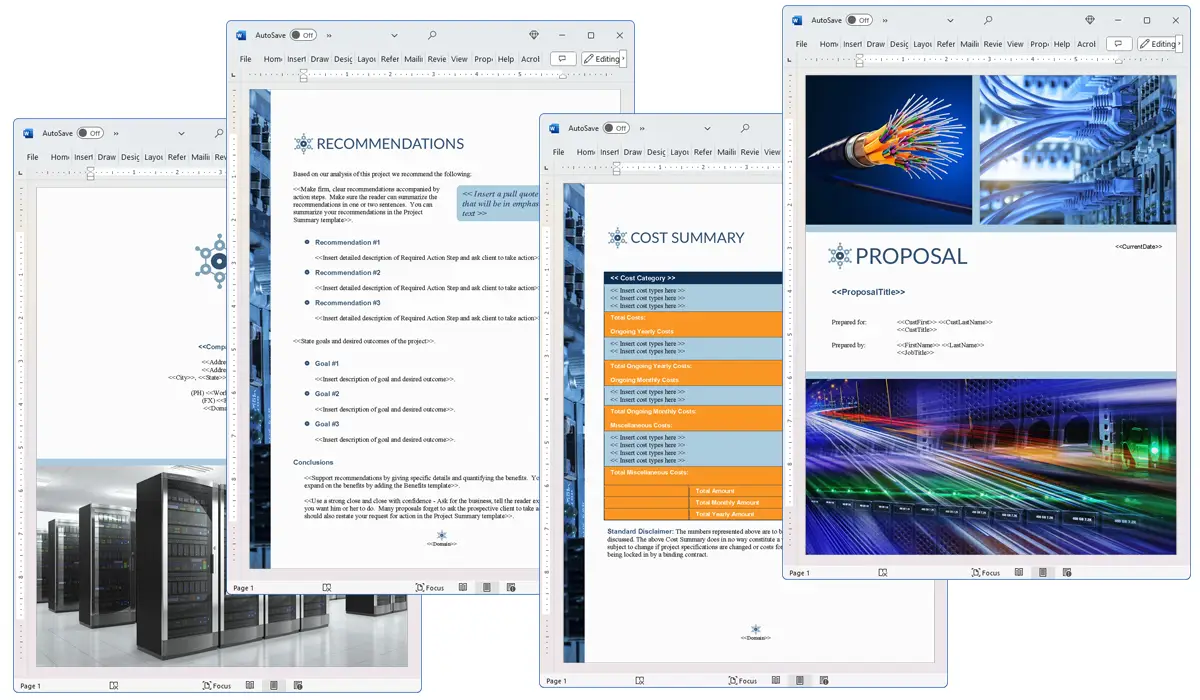What is the Legal Eligibility chapter used for?
Proposal Kit Professional Bundle adds more design themes, all six Contract Packs,
a project management library, and Expert Edition software.

Illustration of Proposal Pack Aqua #7
We include this Legal Eligibility chapter template in every Proposal Pack, along with thousands more. You assemble this chapter with others in various combinations to create custom-tailored business proposals, plans, reports, and other documents. Proposal Packs apply custom visual designs to the templates, giving the final documents a consistent professional finish.
 DOWNLOADABLE, ONE-TIME COST, NO SUBSCRIPTION FEES
DOWNLOADABLE, ONE-TIME COST, NO SUBSCRIPTION FEES
Overview of the Legal Eligibility Chapter
The Legal Eligibility chapter is an important component in a series of templates used to create comprehensive business proposals, particularly when targeting government grants. This chapter serves as a foundational section where a business demonstrates that it has met all the required legal standards and prerequisites to be considered for a grant. Its primary function is to establish the legal standing of a company, ensuring that the proposal reviewers are immediately aware of the applicant's compliance with relevant laws and regulations.
How is the Legal Eligibility Chapter Used?
When used in a business proposal, the Legal Eligibility chapter is placed to make a strong initial impression regarding the legitimacy and lawfulness of a business entity. This chapter is often used early in the proposal document to set the stage for a detailed discussion about the project or service being offered. It reassures the grant reviewers that the entity applying for the grant is legally qualified and reduces any potential concerns about legal encumbrances that might impact the project's execution.
What is Included in the Legal Eligibility Chapter?
Typically, the Legal Eligibility chapter includes several key elements:
- Legal Status: Detailed information about the company's legal formation such as incorporation details, ownership structure, and location.
- Compliance: A summary of compliance with specific legal regulations relevant to the grant or project, including any industry-specific regulations.
- Licenses and Permits: A list of all relevant licenses and permits that the business holds, which are necessary for legally operating within its specific field.
- Previous Grant Eligibility: If applicable, a history of previous grants for which the business was considered legally eligible, enhancing the credibility of the current application.
- Certifications: Details of any legal or professional certifications that support the entity's qualifications in managing the project proposed.
Use Case Examples for the Legal Eligibility Chapter
- Finance: In proposals seeking funding for financial services, verifying that the company holds necessary financial handling certifications and complies with federal financial regulations.
- Insurance: Demonstrating that the insurance firm adheres to state and national insurance regulations, which is crucial for proposals related to policy management services.
- Legal: For legal services grants, showing bar association memberships and any specific legal practice licenses.
- Grants: When applying for research grants, proving compliance with ethical standards and research regulations.
- RFP Responses: In responses to Requests for Proposals (RFPs) from government bodies, detailing legal qualifications important for contract eligibility.
Key Takeaways
- The Legal Eligibility chapter is important for establishing the legal qualifications of a company in business proposals.
- It is particularly crucial in proposals involving government grants, where legal compliance cannot be overstated.
- This chapter typically includes details on legal status, compliance, necessary licenses and permits, and any relevant certifications.
- It serves to reassure proposal reviewers about the legal soundness and readiness of the business to undertake the project.
- Using this chapter can significantly enhance the credibility of a proposal, particularly in sectors like finance, insurance, and legal services, where stringent legal requirements exist.

Illustration of Proposal Pack Agriculture #5
 What Our Clients Say
What Our Clients SayNow, I can respond and bid on any government, non-profit, small or medium businesses RFPs with more confidence. I will refer everyone I know to purchase the Proposal Kit Professional bundle, if they want to write winning and professional proposals."
President
G A G Technology LLC
 4.7 stars, based on 849 reviews
4.7 stars, based on 849 reviewsAlternate Chapters
Samples Using the Legal Eligibility Chapter
Document Layouts Using the Legal Eligibility Chapter

The Legal Eligibility chapter and other chapters are integrated into a Word document as illustrated here in the Proposal Pack Networks #4 design theme. There are hundreds of design themes available, and every design theme includes the Legal Eligibility chapter template.
A proper business proposal will include multiple chapters. This chapter is just one of many you can build into your proposal. We include the complete fill-in-the-blank template in our Proposal Pack template collections. We also include a library of sample proposals illustrating how companies in different industries, both large and small, have written proposals using our Proposal Packs. This template will show you how to write the Legal Eligibility.
We include a chapter library for you to build from based on your needs. All proposals are different and have different needs and goals. Pick the chapters from our collection and organize them as needed for your proposal.
Using the Proposal Pack template library, you can create any business proposal, report, study, plan, or document.
The Wizard software includes an AI Writer, which will write the content of this and any other chapter of your document. Use the AI Writer to do the heavy lifting, writing the first draft of your proposal or business document in minutes.
 Ian Lauder has been helping businesses write their proposals and contracts for two decades. Ian is the owner and founder of Proposal Kit, one of the original sources of business proposal and contract software products started in 1997.
Ian Lauder has been helping businesses write their proposals and contracts for two decades. Ian is the owner and founder of Proposal Kit, one of the original sources of business proposal and contract software products started in 1997.By Ian Lauder
 Published by Proposal Kit, Inc.
Published by Proposal Kit, Inc.


 Cart
Cart
 Facebook
Facebook YouTube
YouTube Bluesky
Bluesky Search Site
Search Site